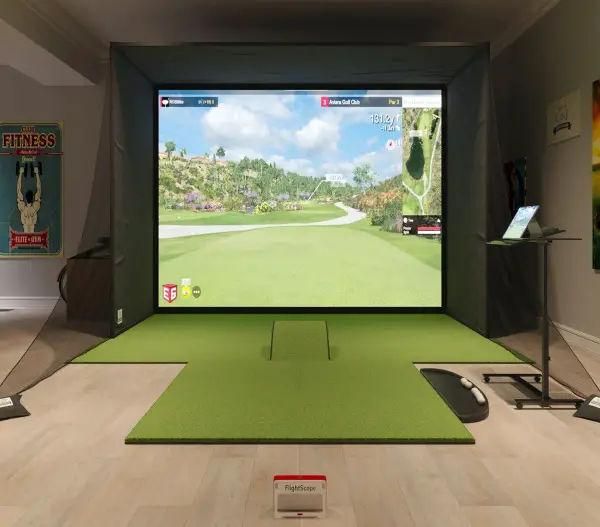How Do Golf Simulators Work

Golf is a beloved sport enjoyed by millions of people around the world. However, it can be challenging to practice and play golf regularly due to factors such as weather, cost, and access to golf courses. Fortunately, the advent of golf simulators has made it easier than ever for golfers to practice and play golf year-round, regardless of their location or weather conditions.
But how do golf simulators work? In this article, we’ll explore the technology and components behind golf simulators, as well as the benefits they offer to golfers of all skill levels. We’ll discuss the key components of golf simulators, such as projectors, screens, simulation software, and sensors, and how they work together to create a realistic and immersive golfing experience.
We’ll also examine the different types of golf simulators available, from home golf simulators to professional-grade simulators used by golf coaches and professional golfers. Additionally, we’ll discuss the benefits of using a golf simulator, such as convenience, affordability, weather independence, and the ability to practice and improve your game in a controlled environment.
By the end of this article, you’ll have a comprehensive understanding of how golf simulators work and how they can benefit golfers of all levels. So, whether you’re a casual golfer looking to improve your game or a professional looking to refine your technique, read on to learn everything you need to know about golf simulators.

Components of Golf Simulators
Before we discuss how golf simulators work, let’s first take a look at the key components that make up these incredible machines.
Projectors
One of the most important components of a golf simulator is the projector. Projectors are used to display the virtual golf course on a screen or wall. High-quality projectors are essential for creating a realistic and immersive golfing experience.
Screens
Screens are another crucial component of golf simulators. These screens are designed to display the projected image from the projectors. Golf simulator screens come in a variety of sizes and styles, ranging from small portable screens to large, custom-built ones.
Golf Simulation Software
Golf simulation software is the backbone of any golf simulator. This software is responsible for creating the virtual golf course and simulating the ball’s flight based on the golfer’s swing. The best golf simulation software is incredibly accurate, allowing golfers to get a realistic sense of how their shots would perform on a real golf course.
Golf Swing Analyzers
Golf swing analyzers are specialized sensors that capture data on the golfer’s swing. These sensors are usually mounted on the golf club and use various technologies, such as accelerometers and gyroscopes, to capture data on the swing’s speed, angle, and trajectory.
Sensors
In addition to golf swing analyzers, golf simulators also use a variety of other sensors to capture data on the golfer’s swing and ball flight. These sensors can include ball launch monitors, which measure the ball’s speed, spin, and launch angle, as well as radar and infrared sensors, which track the ball’s flight path.
How Golf Simulators Work
Now that we’ve covered the key components of golf simulators, let’s take a closer look at how they actually work.
The Process of Golf Simulation
Golf simulation begins with the golfer taking a swing. The golf swing analyzers capture data on the swing, which is then used by the simulation software to calculate the ball’s flight path. This flight path is then displayed on the screen, creating a virtual representation of the golf shot.
Capturing Data Points
To create a realistic simulation, golf simulators capture a vast amount of data points on each shot. These data points can include the ball’s speed, spin, launch angle, and flight path, as well as the swing’s angle, speed, and trajectory. All of this data is then used by the simulation software to create a virtual representation of the shot.
Rendering the Environment
Once the data points have been captured, the simulation software uses this information to create a virtual environment. This environment includes the golf course, the ball’s flight path, and any obstacles or hazards that the golfer may encounter.
Displaying the Simulation
Finally, the golf simulator displays the virtual environment on the screen. The golfer can then see the results of their swing in real-time, allowing them to adjust their technique and improve their game.
Types of Golf Simulators
There are several different types of golf simulators available on the market today. Let’s take a closer look at each one.
Home Golf Simulators
Home golf simulators are designed for personal use and are usually installed in a garage, basement, or spare room. These simulators are a great way for golfers to practice their swing and improve their game from the comfort of their own homes. They are generally smaller and more affordable than professional-grade simulators, making them a popular choice for casual golfers.
Indoor Golf Centers
Indoor golf centers are commercial-grade golf simulators that are designed for use in businesses, such as golf courses or sports facilities. These simulators are often larger and more advanced than home golf simulators, with more accurate sensors and higher-quality projectors and screens.
Professional Golf Simulators
Professional golf simulators are the most advanced type of golf simulator available. These simulators are used by professional golfers and golf coaches to analyze and improve their swings. They are often custom-built and can cost tens of thousands of dollars.
Benefits of Golf Simulators
Golf simulators offer several benefits to golfers of all skill levels. Let’s take a look at some of the most significant advantages of using a golf simulator.
Convenience
One of the most significant benefits of golf simulators is their convenience. Golfers can practice and play golf at any time, regardless of the weather conditions outside. This makes golf simulators an excellent option for golfers who want to improve their game without having to leave their homes.
Affordability
While professional-grade golf simulators can be expensive, home golf simulators are often more affordable. For golfers who want to improve their game without breaking the bank, a home golf simulator can be a cost-effective option.
Weather Independence
Golf simulators are not affected by weather conditions, making them an excellent option for golfers who live in areas with harsh winters or frequent rain. With a golf simulator, golfers can practice and play golf year-round, regardless of the weather outside.
Practice and Improvement
Finally, golf simulators offer a unique opportunity for golfers to practice and improve their game. With accurate sensors and realistic simulations, golfers can get a better understanding of their swing and make adjustments to improve their performance on the golf course.
Choosing a Golf Simulator
If you’re interested in purchasing a golf simulator, there are several factors to consider. Let’s take a closer look at some of the most important considerations.
Space
The first consideration when purchasing a golf simulator is space. Golf simulators can be quite large, so it’s important to ensure that you have enough space to accommodate one.
Budget
Another important consideration is budget. Golf simulators can range in price from a few thousand dollars to tens of thousands of dollars. It’s essential to determine how much you’re willing to spend before making a purchase.
Software
The quality of the simulation software is another crucial consideration. High-quality software is essential for creating a realistic and accurate simulation.
Sensors and Accuracy
Finally, it’s important to consider the sensors and accuracy of the golf simulator. High-quality sensors can capture more data points, resulting in a more accurate simulation.
Popular Brands
Some of the most popular brands of golf simulators include SkyTrak, TrackMan, and OptiShot.
Maintenance and Care of Golf Simulators
Like any piece of equipment, golf simulators require regular maintenance and care to ensure that they continue to function correctly. Some essential maintenance tasks include regular cleaning and software and hardware upgrades. In addition, golfers should be familiar with troubleshooting common issues that may arise with their golf simulator.
Future of Golf Simulators
The future of golf simulators looks bright. As technology continues to advance, we can expect to see even more realistic simulations and advanced sensors. There is even the potential for golf simulators to integrate with virtual reality, allowing golfers to experience the game in a whole new way.
Conclusion
Golf simulators offer golfers a unique and exciting way to practice and improve their game. By understanding the components and technology behind golf simulators, golfers can make an informed decision when purchasing a golf simulator. With the ability to practice year-round, regardless of the weather outside, golfers can improve their game from the comfort of their own homes. Whether you’re a casual golfer or a professional, a golf simulator can help take your game to the next level.





